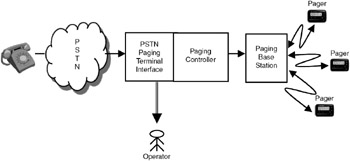Chapter 30: Radio Paging
|
| < Day Day Up > |
|
For people on the move, to be in constant touch with their family members, business associates, and customers is of paramount importance. Radio paging technology provides a very low-cost mechanism for sending information to a person on the move. The information can be numeric digits (for example, a telephone number), alphanumeric text messages, or even voice messages. By keeping the bandwidth of the network low and restricting the functionality of the user terminals, a very low-cost paging service can be provided. In this chapter, we discuss the architecture of the radio paging system and the protocols used for paging. New developments that are taking place in paging technology such as voice paging, automated paging, and two-way paging, are also discussed.
30.1 PAGING SYSTEM ARCHITECTURE AND OPERATION
The architecture of a paging system is shown in Figure 30.1. The paging system consists of a base station that broadcasts the paging messages to a service area. The base station is interfaced to a paging controller. The message is composed by an operator who receives the message from a user through a telephone. The paging controller has the necessary hardware and software for handling the paging protocols. The message is broadcast through the base station using radio as the transmission medium.

Figure 30.1: Paging system.
In a simulcast paging system, a paging controller controls a number of base stations. The message is broadcast by all the base stations.
If the service area is very large, one base station may not be enough. In such a case, the paging controller will control a number of base stations as shown in Figure 30.2. Such systems are called simulcast paging systems.

Figure 30.2: Simulcast paging.
Operation: A PSTN subscriber calls an operator at the paging control system and gives the pager number and the message. The operator broadcasts the message, with the pager number included in the format. The message is broadcast in the service area, and all the pagers in the area receive the data. Each pager finds out whether the message is addressed to it by matching its own address with the address received. If the received address matches the pager's own address, then the message will be displayed on the pager; otherwise it is discarded by the pager.
In a paging system, the message is broadcast from the paging control system. All the paging terminals (or pagers) receive the message, but only the pager whose address matches with the received address displays the message.
Capacity of the paging system: The following parameters decide the capacity of the paging system. When designing a paging system, these parameters need to be considered.
Number of trunks from the paging controller to the PSTN (which decides the number of persons who can call the paging controller simultaneously)
-
Data rate (50bps, 100bps, 300bps, etc.)
-
Code capacity (number of pagers)
-
Support for different types of pagers
| Note | A large city can be served by a single paging system. However, the capacity of the paging system is decided by the data rates supported and the various types of pagers. |
|
| < Day Day Up > |
|
EAN: 2147483647
Pages: 313